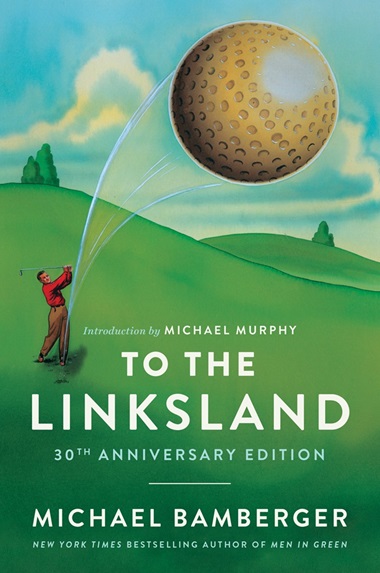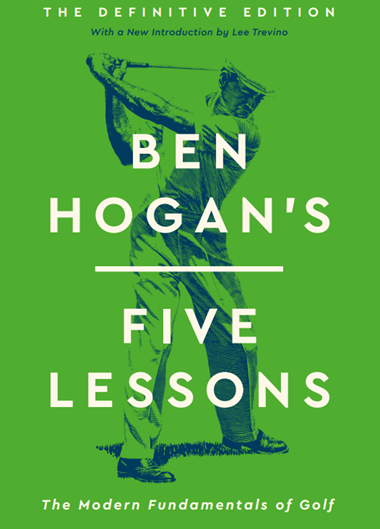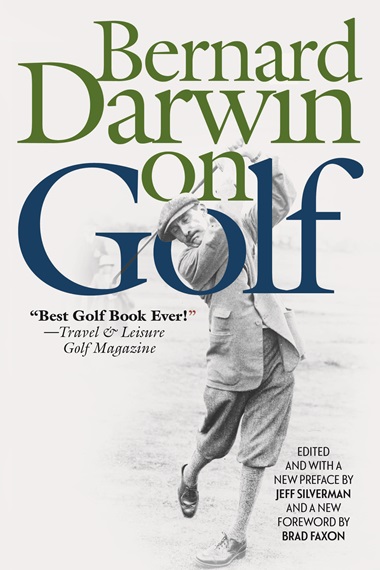Gulliver’s Travels author Jonathan Swift usually gets credit for the line, “Everything old is new again.” For our purposes, we’ll merely thank two publishers for reissuing three books that are old and older, but remain vibrant and rewarding classics, must-haves in any respectable golf library.
They may be on your shelf already, but each of the three are in new editions with some additional material along with the original, and in a word, they’re all marvelous.
 I’ve expressed my admiration for Michael Bamberger’s books in these pages several times, and never having read his early work, To the Linksland (Avid Reader Press, $30). was happy to receive a new 30th Anniversary Edition, which comes with a forward by Michael Murphy of Golf in the Kingdom fame, and an afterword by Bamberger that updates us on some of the characters in the book.
I’ve expressed my admiration for Michael Bamberger’s books in these pages several times, and never having read his early work, To the Linksland (Avid Reader Press, $30). was happy to receive a new 30th Anniversary Edition, which comes with a forward by Michael Murphy of Golf in the Kingdom fame, and an afterword by Bamberger that updates us on some of the characters in the book.
I say characters, since the book reads like a novel, but it’s not. The people mentioned are real, even if there’s an almost mythical tone (like Murphy’s book, which is a novel) to this account of Bamberger’s journey abroad to caddy on the European Tour, and then roam around Scotland in search of his lost golfing self.
Bamberger was lucky in love; his newlywed wife, Christine, quit her job in New York advertising while he took a leave of absence from his Philadelphia Inquirer post so they could throw caution to the winds for the year’s odyssey, which took them all around Europe. Bamberger talked a journeyman pro, an American named Peter Teravainen, into letting him caddie for a round, and it went well enough that it became a regular gig.
Teravainen is such a quirky and compelling figure, and the logistics of caddying and traveling on the tour often downright comedic, that Bamberger could have filled even more pages about it all and left readers satisfied. But that’s only the half of it.
In trying to find the spark that once existed in his own game, Bamberger leaves the tour and the couple settles for a time in Scotland. He seeks out John Stark, the pro at the Crieff Golf Club whom a tour player had put him on to as a master teacher. Stark takes Bamberger on and the book takes off on more adventures.
Stark, who teaches in a gnomic, Shivas Irons kind of way, sends Bamberger off to classic courses like Cruden Bay, Royal Dornoch, Machrihanish, while taking him to Auchnafree, a six-hole course built by a shepherd and which seems like a portal to another world.
An enchanting world, too, as anyone fully under the spell of golf knows. Bamberger has the religion, and he puts it to magical good use here.
<<<>>>
 In one talk with Bamberger, Stark mentions how Hogan came to Scotland for his sole Open Championship win in 1953 (one of his nine majors) and changed the game there forever with his analytic dissection of Carnoustie.
In one talk with Bamberger, Stark mentions how Hogan came to Scotland for his sole Open Championship win in 1953 (one of his nine majors) and changed the game there forever with his analytic dissection of Carnoustie.
Four years later, with the assistance of writer Herbert Warren Wind and artist Anthony Ravielli, Hogan put down in print the basics of his swing. It started out as a five-part series in the relatively young magazine, Sports Illustrated. It worked out well for all. The series was enormously popular, which led to the book, and as far as I know, Ben Hogan’s Five Lessons: The Modern Fundamentals of Golf, has never since been out of print.
Now we have “The Definitive Edition” from Avid Reader Press ($28.99), which includes a new introduction from Lee Trevino noting how he devoured the series while on a marine troop ship sailing from San Diego to Yokohama. It made an impact. When the eventual six-time major winner wrote his own instructional book, Groove Your Swing My Way, he dedicated it to Hogan.
What’s in the new edition? The five lessons, of course, with the original text and Ravielli’s incisive drawings:
> The Grip
> Stance and Posture
> The First Part of the Swing
> The Second Part of the Swing
> Summary and Review
Hogan was a supreme tactician, notorious for practicing hours at a time. As far as the lessons go, readers will find them useful or abstruse, or both. A little minutiae goes a long way, but all five lessons are presented in a tidy 109 pages, buttressed by Hogan’s all caps belief: “THE AVERAGE GOLFER IS ENTIRELY CAPABLE OF BUILDING A REPEATABLE SWING AND BREAKING 8O.”
This “average golfer” shows up quite a bit throughout the text, and if his attention starts to wander, Hogan does drop in a few biographical and playing anecdotes to enliven matters.
But what this edition really delivers on is a new section called “History, Context and Legacy” that adds almost 100 pages of old and new articles and appreciations about Hogan—columns by Red Smith, Dan Jenkins, Dave Anderson and, what do you know, Michael Bamberger. There’s an interview with Ken Venturi, and an introduction from James Dodson’s book, Ben Hogan: An American Life. There’s an even a John Garrity nod to Herbert Warren Wind, one of the more elegant writers on the game.
<<<>>>
 An apt essay not in the book is “That Small Colossus: Hogan at Carnoustie,” a 1934 piece by England’s Bernard Darwin (“… here was such a player as occurs only once in a generation or indeed once in a lifetime…”). Luckily, it can be found in Bernard Darwin on Golf (Lyons Press, $26.95), edited by Jeff Silverman. When it first appeared more than 20 years ago Travel & Leisure Golf magazine called it the best golf book of all time.
An apt essay not in the book is “That Small Colossus: Hogan at Carnoustie,” a 1934 piece by England’s Bernard Darwin (“… here was such a player as occurs only once in a generation or indeed once in a lifetime…”). Luckily, it can be found in Bernard Darwin on Golf (Lyons Press, $26.95), edited by Jeff Silverman. When it first appeared more than 20 years ago Travel & Leisure Golf magazine called it the best golf book of all time.
Silverman, who is here in a new edition with a new preface (and a forward by Brad Faxon), knows it has little to do with him, and everything to do with Darwin, the most elegant writer on the game. And, yes, the grandson of Charles Darwin, but with a scant allotment of any of his ancestor’s scientific genes, a subject of one of the early pieces in this generous collection of almost 80 of his essays.
Darwin was relentless in his regularity; the pieces are culled from weekly golf columns he wrote for The Times and Country Life magazine from 1907 into the late 1950’s, as well as from other magazine pieces and his books.
Darwin was a good player himself and all the pieces are informed by his love of and deep understanding of the sport. But he knew the game can be fickle. He writes with a certain British gentility, to be sure, poised and calm, but shot through with a bracing dry wit and self-deprecation.
The graceful prose is a sheer pleasure to read—a literary delight, really, that will also up your literary game. The essays are replete with literary allusions that will surely have you dashing to Google. But most of them will have something to do with Dickens’ characters; Darwin was also an expert Dickensian.
 He writes about the greats of his time—Hogan, Bobby Jones, Francis Ouimet—great courses, course architecture and course etiquette, the travails of the high handicapper, and in a particularly poignant closing piece, about giving up the game (in his case, due to arthritis). But the particular topic almost doesn’t matter. If you love golf, you’ll know you’re in good hands.
He writes about the greats of his time—Hogan, Bobby Jones, Francis Ouimet—great courses, course architecture and course etiquette, the travails of the high handicapper, and in a particularly poignant closing piece, about giving up the game (in his case, due to arthritis). But the particular topic almost doesn’t matter. If you love golf, you’ll know you’re in good hands.
This piece originally appeared in the Oct.-Nov. 2024 issue of Golf Oklahoma, in slightly different form.
